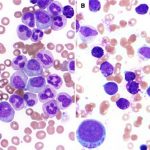Benzene is a naturally occurring chemical but is also a chemical that is used in the production of a range of products, including plastics, solvents, paints, dyes, and a range of chemical and household products.
It is also to be found in the petroleum industry as well as in cigarette smoke.
This chemical is known to cause a range of health problems and ailments, including a number of types of leukaemia and blood disorders. It has been classed by the Environmental Protection Agency as a Class A carcinogenic.
The knowledge of problems relating to benzene exposure are thought to date back as far as 1897, when there were case reports of blood disease caused by exposure to the chemical.
In 1928 the first report that showed that Benzene could cause leukaemia was published.
This was followed in the late 1940s by a toxicity review by the American Petroleum Institute, which showed that high level Benzene exposure caused leukaemia.
Another study into the matter was conducted in 1977, and another report was filed regarding the link between Benzene and leukaemia. Other studies conducted since that time have confirmed the link between the chemical and leukaemia.
Benzene has been linked to a number of ailments and disorders, most notably leukaemia. There are a number of symptoms that are linked with Benzene exposure, which include:
- Fatigue
- Malaise
- Abnormal bleeding
- Excessive bruising
- Weakness
- Reduced tolerance to exercise
- Weight loss
- Bone or joint pain
- Infection and fever
- Abdominal pain or discomfort
- Enlarged spleen, lymph nodes, and liver
The chemical has also been linked to a range of ailments from respiratory problems and skin related effects to blood disorders and cancer.
Those exposed to Benzene regularly or in high doses, particularly those regularly exposed on an occupational basis, are at risk from the cancerous effects of the chemical.
Benzene is linked with an increased risk of leukaemia, and some of the cancers associated with this chemical include: acute myelogenous leukemia (AML), acute lymphocytic leukemia (ALL), chronic myelogenous leukemia (CML), chronic lymphocytic leukemia (CLL), hairy cell leukemia (HCL), non-Hodgkin’s lymphoma (NHL), Hodgkin’s disease, multiple myeloma, myelodysplastic syndrome (MDS).
The highest risk group is considered to be those that work with Benzene, as the occupational exposure means that these people are likely to ingest this chemical in far higher levels than most.
Those working with petroleum based solvents are classed as high risk because they inhale the vapors released from the solvent products, as well as through the skin in the event that the solvent makes contact with the skin during work.
Some of the high risk group occupations have been identified as chemical workers, refinery workers, rubber workers, printers, leather workers, press workers, painters, and gasoline distributors.
Benzene is also present in cigarette smoke, and smokers have been identified as having a slightly increased risk of contracting leukaemia.
The effects of Benzene exposure can take some years to manifest, and in some cases people that have worked with solvents or with the chemical in some other form have discovered years later that they have contracted leukaemia or some other blood related disorder.
Those that have worked with the chemical – or still work with it is some form – are advised to seek medical advice and advise their doctor of their profession and exposure to Benzene.






